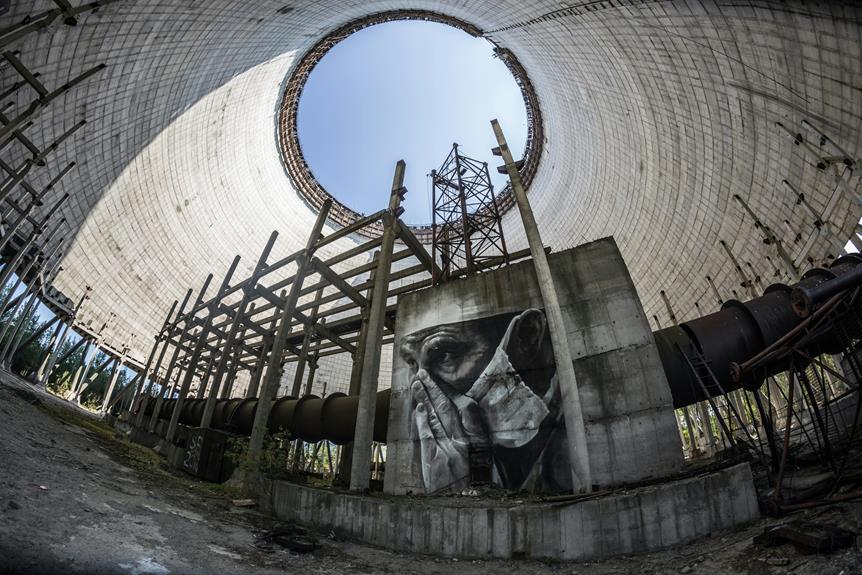The impact of the Fukushima disaster in 2011 continues to reverberate globally, prompting reflections on the implications of nuclear energy, disaster preparedness, and environmental sustainability. The events at the Fukushima Daiichi Nuclear Power Plant triggered a series of consequences that have challenged traditional notions of safety, recovery, and resilience. As we explore the aftermath of this disaster, it becomes evident that Fukushima represents more than a singular event but rather a complex tapestry of interconnected issues that demand attention and contemplation.
Key Takeaways
- Fukushima Daiichi Nuclear Power Plant disaster in 2011
- Ongoing cleanup and decommissioning efforts
- Environmental impact on soil, water, and marine life
- Evacuation, monitoring, and resettlement initiatives
- Development of tourism, agriculture, and cultural resilience
History of Fukushima Disaster
The Fukushima disaster, which occurred on March 11, 2011, was a catastrophic event resulting from a severe earthquake and subsequent tsunami in Japan. The causes of this disaster can be traced back to the magnitude 9.0 earthquake that struck off the coast of Japan, leading to the tsunami that overwhelmed the Fukushima Daiichi Nuclear Power Plant. The earthquake resulted in the loss of external power to the plant, leading to a station blackout and causing the reactors to automatically shut down. The tsunami then flooded the plant, damaging the backup generators and essential cooling systems, ultimately leading to a series of core meltdowns and hydrogen explosions.
The aftermath of the Fukushima disaster was significant and far-reaching. The immediate impact included the evacuation of over 150,000 residents from the surrounding areas to prevent exposure to harmful levels of radiation. The disaster also raised concerns about nuclear safety worldwide, leading many countries to reevaluate their nuclear energy policies. Japan itself underwent a significant shift in its energy strategy, with a move towards renewable energy sources and a gradual phase-out of nuclear power. The cleanup and decommissioning efforts at the Fukushima Daiichi plant continue to this day, highlighting the long-term consequences of nuclear accidents.
Impact on Environment
Significant contamination of soil and water sources in the vicinity of the Fukushima Daiichi Nuclear Power Plant resulted from the disaster. The release of radioactive materials into the environment had profound implications for marine life in the region. The marine ecosystem faced severe radiation effects, impacting various species and their habitats.
The radiation released into the ocean affected marine organisms in several ways. It led to bioaccumulation, where radioactive substances accumulated in the tissues of organisms over time. This accumulation posed risks not only to the individual organisms but also to the predators higher up the food chain, resulting in potential long-term consequences for the entire marine ecosystem. Additionally, the radiation effects on marine life included genetic mutations, reproductive abnormalities, and a decline in population numbers.
The contamination of water sources near the Fukushima Daiichi plant also had far-reaching consequences. It affected not only aquatic organisms directly exposed to the contaminated water but also terrestrial animals and plants dependent on these water sources. The long-term effects of this contamination on the environment are still being studied, as the complex interactions between different species and ecosystems continue to unfold in the aftermath of the disaster. Efforts to monitor and mitigate the impact on marine life and the environment remain ongoing.
Evacuation and Resettlement Efforts
Evacuation and resettlement initiatives following the Fukushima nuclear disaster focused on relocating affected populations to safer areas and establishing new living arrangements to minimize radiation exposure risks. The challenges faced during the evacuation process were significant, including logistical hurdles, psychological impacts on evacuees, and the need for long-term planning to guarantee the well-being of displaced communities. Despite these obstacles, extensive efforts were made to facilitate the safe relocation of residents and initiate the rebuilding of affected communities.
Key aspects of the evacuation and resettlement efforts included:
- Emergency Evacuation: Immediate evacuation protocols were activated to swiftly move residents out of high-risk zones to emergency shelters and designated safe areas.
- Temporary Housing: Provision of temporary housing facilities to accommodate evacuees while long-term resettlement plans were developed and implemented.
- Radiation Monitoring: Continuous monitoring of radiation levels in evacuated areas to assess safety for potential return and to guide resettlement decisions.
- Community Engagement: Engaging with displaced communities to address their concerns, provide support, and involve them in the rebuilding process to restore a sense of normalcy and community cohesion.
Efforts focused not only on the physical relocation of individuals but also on the emotional and social aspects of community rebuilding, recognizing the importance of holistic recovery in the aftermath of such a catastrophic event.
Nuclear Decommissioning Process
Initiating the meticulous process of nuclear decommissioning following the Fukushima disaster required a thorough strategy encompassing intricate technological procedures and stringent safety protocols. The decommissioning challenges faced were multifaceted, ranging from the necessity to remove highly radioactive fuel debris to guaranteeing the containment of hazardous materials. Safety protocols were paramount throughout the process to protect both the environment and the workers involved in the decommissioning efforts.
One of the primary decommissioning challenges was the unprecedented levels of radiation within the reactor buildings, making it difficult for workers to access and dismantle the damaged structures. To address this, robotic technologies were developed to perform tasks in high radiation areas, reducing human exposure. Additionally, the management of radioactive waste generated during decommissioning posed a significant challenge, requiring specialized containment and disposal methods to prevent environmental contamination.
Stringent safety protocols were implemented to safeguard the health and well-being of workers and the surrounding communities. These protocols included continuous monitoring of radiation levels, strict decontamination procedures, and the use of protective equipment. Regular training sessions were conducted to make certain that all personnel adhered to safety guidelines and protocols, minimizing the risk of radiation exposure.
Cultural Resilience and Traditions
Cultural resilience and traditions play a pivotal role in the post-disaster recovery process, providing a framework for communities to maintain their societal identity and cohesion amid challenging circumstances. In the case of Fukushima, Japan, following the 2011 nuclear disaster, cultural preservation and community resilience have been instrumental in rebuilding the region. Here are four key ways in which cultural resilience and traditions have helped Fukushima recover:
- Cultural Preservation: Efforts to preserve traditional arts, crafts, and rituals have not only safeguarded centuries-old practices but have also acted as a source of pride and continuity for the community. By maintaining these cultural elements, Fukushima residents find strength and connection to their heritage, fostering a sense of resilience.
- Community Engagement: Encouraging community participation in cultural events, festivals, and ceremonies has promoted a sense of togetherness and solidarity. These shared experiences have helped residents support each other through difficult times and build a sense of unity that is essential for recovery.
- Inter-generational Transmission: Passing down cultural knowledge and traditions from one generation to the next has guaranteed the preservation of Fukushima's cultural heritage. This transmission of values and practices has not only kept traditions alive but has also instilled a sense of resilience in the younger members of the community.
- Adaptation and Innovation: While preserving traditional practices, Fukushima has also embraced adaptation and innovation. By incorporating modern elements into their cultural activities, the community demonstrates its ability to evolve while staying true to its roots, showcasing resilience in the face of adversity.
Tourism and Fukushima Today
Following the 2011 nuclear disaster, the tourism sector in Fukushima has undergone significant developments, reflecting the region's resilience and transformation in the aftermath of the crisis. Efforts towards economic revitalization have been central to the revival of Fukushima's tourism industry. Through strategic investments in infrastructure, marketing campaigns, and the development of new tourist attractions, the region has been successful in attracting visitors back to Fukushima.
Community support has played an essential role in rebuilding trust and confidence in Fukushima as a tourist destination. Local residents, businesses, and government entities have collaborated to enhance the overall visitor experience, ensuring the safety and well-being of tourists while promoting the unique cultural heritage of the region. Initiatives such as community-led tours, cultural events, and homestay programs have fostered a sense of connection and solidarity between tourists and the local community.
The diversification of tourism offerings in Fukushima has also contributed to its resurgence as a popular destination. Beyond its historical sites and natural landscapes, Fukushima now boasts a range of contemporary attractions, including art galleries, culinary experiences, and eco-tourism activities. By catering to a wider range of interests and preferences, Fukushima has broadened its appeal to domestic and international tourists alike, further driving the region's economic recovery and long-term sustainability.
Agricultural Recovery Initiatives
Efforts to enhance agricultural sustainability and productivity in Fukushima post-nuclear disaster have been pivotal in the region's recovery and resilience. In the aftermath of the Fukushima disaster, sustainable farming practices and community support have played a vital role in revitalizing the agricultural sector. Here are four key initiatives that have contributed to the agricultural recovery in Fukushima:
- Implementation of Organic Farming Techniques: Many farmers in Fukushima have shifted to organic farming methods to guarantee the safety and quality of their produce. By avoiding synthetic pesticides and fertilizers, they are promoting sustainable agriculture while rebuilding consumer trust in Fukushima's agricultural products.
- Collaboration with Research Institutions: Partnerships between local farmers and research institutions have led to the development of innovative farming techniques tailored to Fukushima's unique challenges. These collaborations have facilitated the adoption of cutting-edge technologies to increase productivity and resilience in the face of environmental risks.
- Promotion of Community-Supported Agriculture (CSA) Programs: Community-supported agriculture initiatives have gained traction in Fukushima, fostering direct relationships between farmers and consumers. By participating in CSA programs, residents can support local farmers while gaining access to fresh, locally grown produce.
- Training and Education Programs for Farmers: To ensure the long-term success of sustainable farming practices, training and education programs have been established to equip farmers with the knowledge and skills needed to thrive in a post-disaster environment. These initiatives aim to empower farmers to overcome challenges and build a resilient agricultural sector in Fukushima.
Future Challenges and Sustainability
Challenges in ensuring long-term sustainability and resilience of Fukushima's agricultural sector post-nuclear disaster continue to pose significant complexities requiring strategic interventions and innovative solutions. The region faces a dual challenge of rebuilding its agricultural industry while safeguarding against future calamities. Implementing disaster preparedness measures and shifting towards renewable energy sources are vital steps towards achieving sustainability.
| Challenges | Strategic Interventions | Innovative Solutions |
|---|---|---|
| Soil Contamination | Decontamination efforts | Hydroponic farming systems |
| Consumer Confidence | Transparency in testing | Blockchain technology |
| Economic Viability | Diversification of crops | Agri-tourism development |
| Climate Change Resilience | Water management strategies | Sustainable agriculture practices |
The recovery of Fukushima's agricultural sector hinges on its ability to adapt to changing circumstances and embrace sustainable practices. Investing in renewable energy infrastructure not only reduces the sector's carbon footprint but also enhances its resilience in the face of future disasters. By integrating disaster preparedness into every aspect of agricultural planning and leveraging renewable energy technologies, Fukushima can pave the way for a more sustainable and secure agricultural future.
Frequently Asked Questions
How Has the Fukushima Disaster Affected Local Wildlife?
The impact of environmental disasters on local wildlife can disrupt ecosystem balance, leading to challenges in wildlife recovery. These events can result in habitat destruction, population decline, and changes in species interactions.
Efforts to restore affected ecosystems involve monitoring wildlife populations, restoring habitats, and implementing conservation measures to support the recovery of local fauna. It is essential to assess the long-term effects of such disasters on wildlife and implement sustainable management practices.
What Measures Are in Place to Prevent Future Nuclear Disasters?
Nuclear safety measures are crucial for disaster prevention. Robust protocols encompass reactor design improvements, emergency response plans, stringent regulatory oversight, and thorough training for personnel.
Continuous advancements in technology, such as passive safety systems and enhanced monitoring capabilities, further bolster preparedness.
International collaboration through information sharing and standardization also plays a pivotal role in ensuring a global commitment to preventing future nuclear disasters.
Are There Health Risks Associated With Consuming Fukushima's Produce?
When evaluating potential contamination risks from food sources, it is vital to contemplate the intricate interplay between agricultural practices, environmental factors, and food safety standards. Consuming produce from regions with historical incidents of contamination may pose health risks due to the presence of harmful substances.
Monitoring and enforcing stringent food safety protocols are indispensable to mitigate such risks and safeguard the public's health and well-being.
How Has the Local Economy Been Impacted by the Nuclear Accident?
The local economy has experienced significant repercussions following the nuclear accident. The incident has led to a decline in job opportunities as certain industries, such as agriculture and fisheries, have been negatively impacted.
Additionally, tourism growth has been stunted due to concerns about safety and lingering radiation fears. These combined effects have created a challenging economic environment for local businesses and residents.
What Innovations Are Being Explored for Sustainable Energy in Fukushima?
What innovations are being explored for sustainable energy in various regions?
Renewable technologies are at the forefront of sustainable energy exploration, with a focus on solar, wind, and hydroelectric power.
Community initiatives play a pivotal role in promoting these technologies, fostering a bottom-up approach to energy sustainability.
How can these innovations be scaled up to meet the growing energy demands of the future while preserving our planet for generations to come?
Conclusion
To sum up, the Fukushima disaster serves as a cautionary tale of the devastating consequences of nuclear accidents.
The region's ongoing challenges in cleanup, decommissioning, and resettlement underscore the complexity of managing nuclear disasters.
Like a phoenix rising from the ashes, Fukushima's resilience and efforts towards sustainability shine as a beacon of hope for a brighter future amidst adversity.


